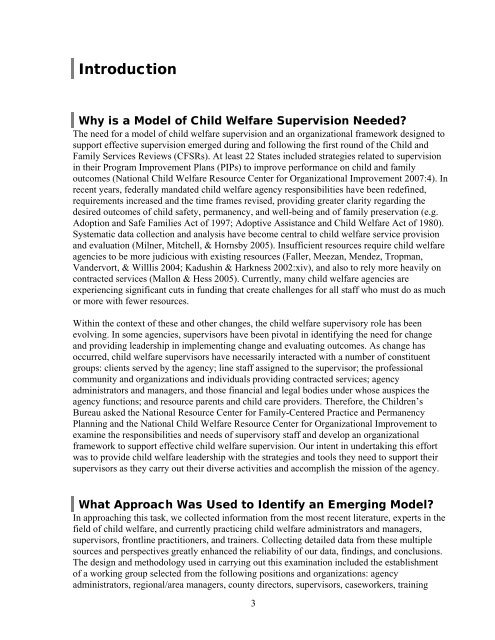Building a Model and Framework for Child Welfare Supervision
Building a Model and Framework for Child Welfare Supervision
Building a Model and Framework for Child Welfare Supervision
- No tags were found...
You also want an ePaper? Increase the reach of your titles
YUMPU automatically turns print PDFs into web optimized ePapers that Google loves.
IntroductionWhy is a <strong>Model</strong> of <strong>Child</strong> <strong>Welfare</strong> <strong>Supervision</strong> Needed?The need <strong>for</strong> a model of child welfare supervision <strong>and</strong> an organizational framework designed tosupport effective supervision emerged during <strong>and</strong> following the first round of the <strong>Child</strong> <strong>and</strong>Family Services Reviews (CFSRs). At least 22 States included strategies related to supervisionin their Program Improvement Plans (PIPs) to improve per<strong>for</strong>mance on child <strong>and</strong> familyoutcomes (National <strong>Child</strong> <strong>Welfare</strong> Resource Center <strong>for</strong> Organizational Improvement 2007:4). Inrecent years, federally m<strong>and</strong>ated child welfare agency responsibilities have been redefined,requirements increased <strong>and</strong> the time frames revised, providing greater clarity regarding thedesired outcomes of child safety, permanency, <strong>and</strong> well-being <strong>and</strong> of family preservation (e.g.Adoption <strong>and</strong> Safe Families Act of 1997; Adoptive Assistance <strong>and</strong> <strong>Child</strong> <strong>Welfare</strong> Act of 1980).Systematic data collection <strong>and</strong> analysis have become central to child welfare service provision<strong>and</strong> evaluation (Milner, Mitchell, & Hornsby 2005). Insufficient resources require child welfareagencies to be more judicious with existing resources (Faller, Meezan, Mendez, Tropman,V<strong>and</strong>ervort, & Willlis 2004; Kadushin & Harkness 2002:xiv), <strong>and</strong> also to rely more heavily oncontracted services (Mallon & Hess 2005). Currently, many child welfare agencies areexperiencing significant cuts in funding that create challenges <strong>for</strong> all staff who must do as muchor more with fewer resources.Within the context of these <strong>and</strong> other changes, the child welfare supervisory role has beenevolving. In some agencies, supervisors have been pivotal in identifying the need <strong>for</strong> change<strong>and</strong> providing leadership in implementing change <strong>and</strong> evaluating outcomes. As change hasoccurred, child welfare supervisors have necessarily interacted with a number of constituentgroups: clients served by the agency; line staff assigned to the supervisor; the professionalcommunity <strong>and</strong> organizations <strong>and</strong> individuals providing contracted services; agencyadministrators <strong>and</strong> managers, <strong>and</strong> those financial <strong>and</strong> legal bodies under whose auspices theagency functions; <strong>and</strong> resource parents <strong>and</strong> child care providers. There<strong>for</strong>e, the <strong>Child</strong>ren’sBureau asked the National Resource Center <strong>for</strong> Family-Centered Practice <strong>and</strong> PermanencyPlanning <strong>and</strong> the National <strong>Child</strong> <strong>Welfare</strong> Resource Center <strong>for</strong> Organizational Improvement toexamine the responsibilities <strong>and</strong> needs of supervisory staff <strong>and</strong> develop an organizationalframework to support effective child welfare supervision. Our intent in undertaking this ef<strong>for</strong>twas to provide child welfare leadership with the strategies <strong>and</strong> tools they need to support theirsupervisors as they carry out their diverse activities <strong>and</strong> accomplish the mission of the agency.What Approach Was Used to Identify an Emerging <strong>Model</strong>?In approaching this task, we collected in<strong>for</strong>mation from the most recent literature, experts in thefield of child welfare, <strong>and</strong> currently practicing child welfare administrators <strong>and</strong> managers,supervisors, frontline practitioners, <strong>and</strong> trainers. Collecting detailed data from these multiplesources <strong>and</strong> perspectives greatly enhanced the reliability of our data, findings, <strong>and</strong> conclusions.The design <strong>and</strong> methodology used in carrying out this examination included the establishmentof a working group selected from the following positions <strong>and</strong> organizations: agencyadministrators, regional/area managers, county directors, supervisors, caseworkers, training3
















